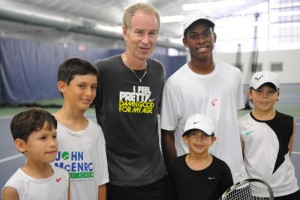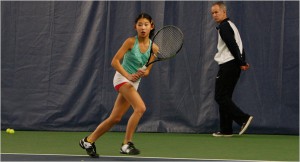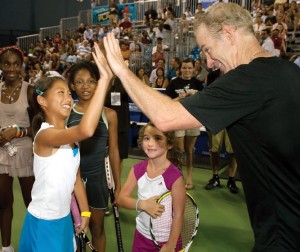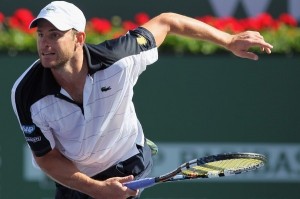By Andrea Leand
Over the Triboro Bridge and down the one and only main road on Randall’s Island, a non-descript little place off the east side of Manhattan, there stands an oversized sign marking the main attraction, the John McEnroe Tennis Academy. Less than two years old, the newly-minted tennis haven has transformed the once unassuming sports club into the hot spot for juniors searching for the same super-stardom as the facility’s namesake.
Inside, the iconic pictures of a younger McEnroe – including his ‘Rebel with a Cause’ classic – line the walls; his mop of wavy hair and competitive scowl resonate from a time McEnroe dominated the sport as its ingeniously talented, if not, belligerent champion.
 It is this persona that had many wondering how McEnroe would pull off an academy for kids. Did such an uncompromising, short-fused star have the patience and temperament to help develop young players? Others asked if McEnroe would show up at all, or follow the foot steps of other tennis stars who have just lent their names in cushy deals rather than their time.
It is this persona that had many wondering how McEnroe would pull off an academy for kids. Did such an uncompromising, short-fused star have the patience and temperament to help develop young players? Others asked if McEnroe would show up at all, or follow the foot steps of other tennis stars who have just lent their names in cushy deals rather than their time.
On this drizzly, weekday afternoon, McEnroe answers those questions quickly. He is front and center on the practice court as well as behind the scenes business meetings. New program director, Lawrence Kleger oversees the afternoon program for elite juniors when McEnroe, fit, trim and on time, appears unassumingly from behind the back court curtain. He didn’t have to wear his earring today to personify cool. Although these kids are too young to have ever seen McEnroe compete in his heyday or win Wimbledon, they are taken with him. They pick up the pace, smacking their shots with more authority and distinction.
They listen to him when he casually mingles to talk about their recent results, strokes, school and family, showing he is as up to date on their progress as he is with all his other endeavors. He looks the role model as he talks about having a balanced diet and gym routine to stay in shape. He has a few words for 16-year-old Noah Rubin, the program’s top player who’s shown some promise in recent ITF events – including a quarterfinal finish at the French Open junior championships.
“John is really modern,” says Rubin. “He just knows how to talk to you. He’s really current. He knows what’s going on. I like talking to him; he says stuff that helps.”
 John McEnroe, the communicator? The patient advisor? The balanced role model? One can even throw in “charming” as he talks about his hopes for his latest endeavor. Clearly, there is this side of the father of six that many have not seen. In fact, for years, McEnroe tried to partner with USTA at its facility in Flushing, N.Y. But when politics, money, ego or a combination thereof deadpanned the discussion, McEnroe partnered with Claude Okin, owner of the well regarded Sportime Clubs, to turn his vision into a reality. As many top academies are adding other sports to keep financially afloat and the USTA is pouring millions into programs for its rookie pros like Christina McHale, Melanie Oudin, Sloane Stephens and Madison Keys and its 10-and-under national campaign for tots, McEnroe is out to produce world champions – as only McEnroe does-his way.
John McEnroe, the communicator? The patient advisor? The balanced role model? One can even throw in “charming” as he talks about his hopes for his latest endeavor. Clearly, there is this side of the father of six that many have not seen. In fact, for years, McEnroe tried to partner with USTA at its facility in Flushing, N.Y. But when politics, money, ego or a combination thereof deadpanned the discussion, McEnroe partnered with Claude Okin, owner of the well regarded Sportime Clubs, to turn his vision into a reality. As many top academies are adding other sports to keep financially afloat and the USTA is pouring millions into programs for its rookie pros like Christina McHale, Melanie Oudin, Sloane Stephens and Madison Keys and its 10-and-under national campaign for tots, McEnroe is out to produce world champions – as only McEnroe does-his way.
McEnroe wants to create the same type of academy that proved so successful for him and his peers when they were growing up. Harry Hopman’s programs at the Port Washington Tennis Academy, nestled in the sleepy Long Island, N.Y. suburb, became legendary as the place to train to become a world class player. The coaching, the competition, the curriculum right down to the free juices and cookies set the standard in producing one champion after another – most notably McEnroe.
“There was something about Mr. Hopman,” says Mark McEnroe, the middle of the three McEnroe brothers who, like John and youngest brother Patrick, trained at the Port Washington Tennis Academy and now runs the operations of the academy / Randalls Island club. “He had a certain presence. You just listened to him. And John has that same type of presence. There is something about him that makes people (take notice) and listen to him.”
McEnroe will spend six hours today on court with the kids but behind closed doors wants plans to find more players, more talent, more results. He did not hesitate to replace his program director with Kleger to make sure everyone was on the same page – his page. And he recently hired long-time friend and doubles partner Peter Fleming as an associate director. McEnroe also wants to expand his program to Sportimes’ other facilities in the New York area to reach out to more kids, hoping to find those young Michael Jordans.
 “We want to get them before they turn to sports like football or basketball,” says McEnroe, the four-time U.S. Open champion. “We want to find these kids and get them interested in tennis.”
“We want to get them before they turn to sports like football or basketball,” says McEnroe, the four-time U.S. Open champion. “We want to find these kids and get them interested in tennis.”
To do so, he wants kids staying in school and living at home for better balance and structure. All levels of tennis programs are offered throughout the day. Eight to ten year olds have fun running and hitting, hopping up in the air to volley balls a bit high and quick volleying with their friends at the back court while waiting their turns. Some try simply to connect with the ball-and then there is the especially athletic eight-year-old who prefers spinning around in a circle between shots. And when he comes to net, he prefers to flip his racket back back and forth between hands so he can hit forehands on both sides.
In the middle of the day, inner-city children shuttle over for gratis time and more structured drills. Later, after school programs – sold out from the first season – host many private school children from Manhatten who can afford the pricey (some say near $10,000) fee for twice weekly, two-hour practices. When McEnroe joins the elite juniors from 6-9, expectation is higher. While his brother (and USTA general manager of junior development), Patrick practices just mere miles away with McHale and Oudin at the USTA’s ever-expanding training facility at the USTA Billie Jean King National Tennis Center in Flushing, McEnroe eyes setting his own standard and steering a better coarse-again.
“When my father graduated law school, he graduated No. 2 in his class, which he thought was pretty good,” says John, “but when he came home and told my mother, she said, ‘why didn’t you graduate No.1?’ She’s always had that thing – to be the best at what you do… And that’s always been with me. I’ve always wanted to be the best. And I want to make this academy the best in the country.”

